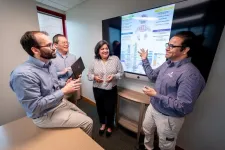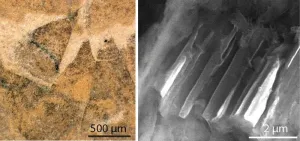(Press-News.org) MADISON — As they are in many places around the globe, glaciers perched high in the Andes Mountains are shrinking. Now, researchers at the University of Wisconsin–Madison and their collaborators have uncovered evidence that the high-altitude tropical ice fields are likely smaller than they've been at any time since the last ice age ended 11,700 years ago.
That would make the tropical Andes the first region in the world known to pass that threshold as a result of the steadily warming global climate. It also makes them possible harbingers of what's to come for glaciers globally.
"We think these are the canary in the coal mine. The tropics would probably be the first place you'd expect ice to disappear, and that's what we're seeing," says Shaun Marcott, a professor of geoscience at UW–Madison. Marcott guided the research with colleagues at Boston College and Tulane University. Andrew Gorin, a former Boston College graduate student who is now at University of California, Berkeley, led the study, which appears in the Aug. 2, 2024, issue of the journal Science.
Glaciers grow slowly over time in regions where summer weather isn't warm enough to melt all of the previous winter's snowfall. Over time, unmelted snow collects and gets compacted and begins to move under its own weight, resulting in the year-round ice that defines a glacier.
Satellite imagery and on-the-ground observations have provided conclusive evidence for decades that high-altitude glaciers in the Andes are steadily shrinking as warmer temperatures cause them to melt more quickly than falling snow can replenish them.
What has remained unclear, though, is whether the glaciers' dwindling footprints are anomalously small compared to the rest of the period that began at the end of the last ice age, known as the Holocene. Meanwhile, glaciers in other parts of the world were smaller at some points in the early Holocene, when the global climate was warmer and drier than recent millennia.
“We knew that glaciers ebbed and flowed in the past, so we wanted to learn how the behavior of glaciers today — melting due to human-caused climate change — stacks up against their long-term fluctuations,” says Andy Jones, a UW–Madison doctoral student and study co-author.
To answer this question, the team of scientists analyzed the geochemistry of bedrock from areas near the edges of four glaciers in the high tropical Andes, choosing sites that satellite imagery showed were exposed by melting ice in only the last two or three decades.
The team specifically looked for evidence of two unique isotopes — basically chemical flavors — of a pair of elements with the bedrock's quartz crystals: beryllium-10 and carbon-14. These isotopes are only present in rock that has spent time at or near the Earth's surface as they result from interactions between the rock and cosmic rays, which are high-energy particles that constantly rain down on the planet from outer space.
Bedrock accumulates beryllium-10 and carbon-14 once it's exposed to the surface, so measuring the isotopes' concentrations in rock crystals near glaciers can be useful for understanding the previous extent of ice coverage.
The team found "remarkably low" concentrations of both isotopes in nearly all samples, suggesting that melting ice has exposed bedrock near the glaciers for the first time only recently in most of the sampled locations.
Additional analyses — and the fact that the extremely low concentrations were consistent across sample sites — made the researchers confident that melting ice, rather than erosion, exposed the bedrock.
"It's highly unlikely this is from erosion," says Marcott. "Because the multiple locations we went to all show the same thing."
This consistency points to a single likely conclusion, according to Marcott: The world's tropical glaciers, more than 99% of which are located in the Andes, are the first to shrink beyond what's been seen in the recent geologic past.
"Glaciers are very sensitive to the climate system that they live in," says Marcott. "They really are the place you would look to see some of the first big changes resulting from a warming climate. You can look to these glaciers and imagine what we might be looking at going into the future in other places like the Western United States, which is a no-ice scenario."
This research was supported by the National Science Foundation (EAR-1805620; EAR-1805133; EAR-1805892).
# # #
--Will Cushman, wcushman@wisc.edu, 608-263-1986
END
Scientists at St. Jude Children’s Research Hospital have created a panel that is able to provide a diagnosis for >90% of pediatric cancer patients by sequencing 0.15% of the human genome. The panel is a cost-effective way to test and classify childhood malignancies and to help guide patient treatment. The panel’s performance and validation were published this week in Clinical Cancer Research.
Finding the mutations in a child’s cancer with powerful sequencing technology can lead to better outcomes. Physicians use that knowledge to tailor targeted treatments to the specific cancer-causing mutations affecting each patient. However, current ...
Prior authorization—the process by which a health insurance company denies or approves coverage for a health care service before the service is performed—became standard practice beginning with Medicare and Medicaid legislation in the 1960s.
Although research has uncovered disparities in prior coverage for cancer patients based on race, little has been known to date on the role of prior authorization in increasing or decreasing these disparities.
To learn more about the issue, Benjamin Ukert, PhD, an assistant professor of health policy and management in the Texas A&M ...
UNIVERSITY PARK, Pa. — Snacks provide, on average, about one-fourth of most people’s daily calories. With nearly one in three adults in the United States overweight and more than two in five with obesity, according to the National Institutes of Health, researchers in the Penn State Sensory Evaluation Center are investigating how Americans can snack smarter.
The latest study conducted in the center, housed in the College of Agricultural Sciences, investigated how eating behavior changes when consumers are served a dip with a salty snack. The findings, available online now and to be published in the November issue ...
Seven entrepreneurs comprise the next cohort of Innovation Crossroads, a Department of Energy Lab-Embedded Entrepreneurship Program node based at Oak Ridge National Laboratory. The program provides energy-related startup founders from across the nation with access to ORNL’s unique scientific resources and capabilities, as well as connect them with experts, mentors and networks to accelerate their efforts to take their world-changing ideas to the marketplace.
“Supporting the next generation of entrepreneurs is part of ORNL’s ...
FOR IMMEDIATE RELEASE
Aug. 1, 2024
Media Contact:
Monica McDonald
(404) 365-2162
mmcdonald@rheumatology.org
American College of Rheumatology Opens Press Registration for ACR Convergence 2024
ATLANTA – Complimentary press registration is now open for journalists to cover research presented at ACR Convergence 2024, taking place Nov. 14-19 at the Walter E. Washington Convention Center in Washington, D.C. A listing of sessions for the meeting can be found in the online program.
Approved ...
UNDER EMBARGO UNTIL 19:00 BST / 14:00 ET THURSDAY 1 AUGUST 2024
Images available via link in the notes section
Exceptional fossils with preserved soft parts reveal that the earliest molluscs were flat, armoured slugs without shells.
The new species, Shishania aculeata was covered with hollow, organic, cone-shaped spines.
The fossils preserve exceptionally rare detailed features which reveal that these spines were produced using a sophisticated secretion system that is shared with annelids (earthworms and relatives).
A team of researchers including scientists from the University of Oxford have made an astonishing discovery of ...
When the question is “how are you feeling on the inside?,” it’s our vagus nerve that offers the answer.
But how does the body’s longest cranial nerve, running from brain to large intestine, encodes sensory information from the visceral organs? For his work investigating and mapping this internal information highway, Qiancheng Zhao is the 2024 grand prize winner of the Science & PINS Prize for Neuromodulation.
Interoception—the body’s ability to sense its internal state in a timely and precise manner—facilitated by the vagus plays a key role in respiratory, gastrointestinal, cardiovascular, endocrine and immune ...
Andean tropical glaciers are experiencing unprecedented retreat, according to a new study that reveals their current sizes are the smallest in over 11,700 years. “Our finding … identifies this region as a hot spot in our understanding of the changing state of the cryosphere,” say the authors. Glaciers act as important indicators of climate change, with their global retreat accelerating over recent decades. Examining this retreat in the context of the previous 11,700 years of the Holocene interglacial highlights the impact of modern global warming. Although many glaciers worldwide are smaller today compared to ...
The early evolution of mollusks has been hard to pin down, but now a newly discovered fossil – of a shell-less, soft-bodied, spiny mollusk from the early Cambrian – provides crucial insights, researchers report. The findings suggest that this fossil, of a creature called Shishania aculeata, is a stem mollusk – representative of an intermediate between early members of the superphylum lophotrochozoans and more derived mollusks. Mollusks are one of the most diverse groups of animals, encompassing various well-known forms such as clams, ...
Researchers have developed a novel approach to three-dimensional (3D) printing they call “CLEAR,” which significantly improves the strength and durability of materials by using a combination of light and dark chemical reactions to create densely entangled polymer chains. The authors used their approach to print structures with special features, such as the ability to adhere to wet tissues. Incorporation of polymer chain entanglements as reinforcements within 3D printed materials can significantly enhance their mechanical properties. However, traditional vat photopolymerization-based 3D printing techniques, such as digital ...



